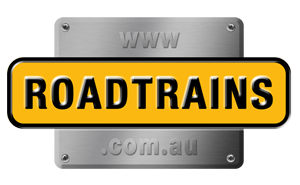How to Couple and Uncouple a Fifth Wheel on a prime mover is a skill that should be mastered before a driver get’s their heavy combination licence. Yet there are an increasing number of photos posted on social media of trailers being dropped. We sent our resident trainer-assessor, Howard Shanks, to find out why is this happening and importantly explain the correct procedure to connect and disconnect a prime mover and semi-trailer.

How to Couple and Uncouple a Fifth Wheel on a prime mover
According to several fleet operations managers we questioned two common factors emerged, complacency was the most common factor after investigations, where drivers were found to be were taking short cuts during the coupling procedure followed by drivers being distracted while coupling their trailers.
Sadly in recent times there has been an increase in dropped trailers due to vandalism where the fifth wheel’s lever has been pulled while a driver has been taking a fatigue break.
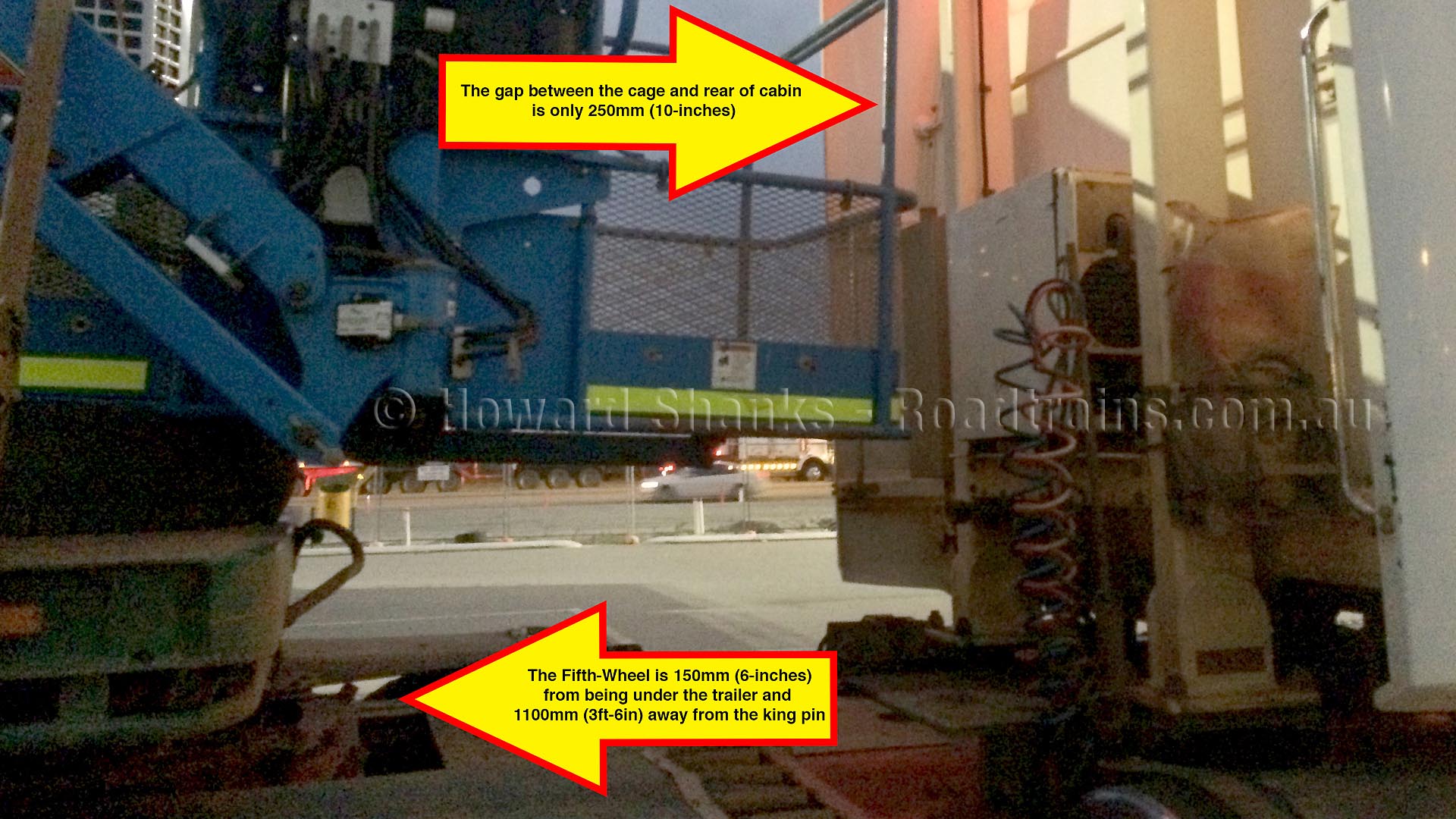
Visually inspect to see there are no obstructions when coupling
Visual Inspection
According to Jost Australia’s Bob Martin, this has caused several fleets to amend their operating procedures to include a visual inspection to ensure the trailers are coupled at the end of every fatigue break.
“We are hearing of this more and more,” Bob said. “I can’t emphasis enough to drivers that they need to walk around their truck and check their trailers are connected after each stop, especially when they’ve parked in a public truck stop.”
However it’s not all bad news, Highland Haulage owner Mick Linger firmly believes that training and refresher courses for all drivers will make the industry much safer and more profitable with less costs wasted repairing damaged equipment.
“We run a comprehensive online training system on how to Couple and Uncouple a Fifth Wheel on a prime mover not just for our own staff, but we make it available for anyone working in the transport industry too,” Mick Linger said.
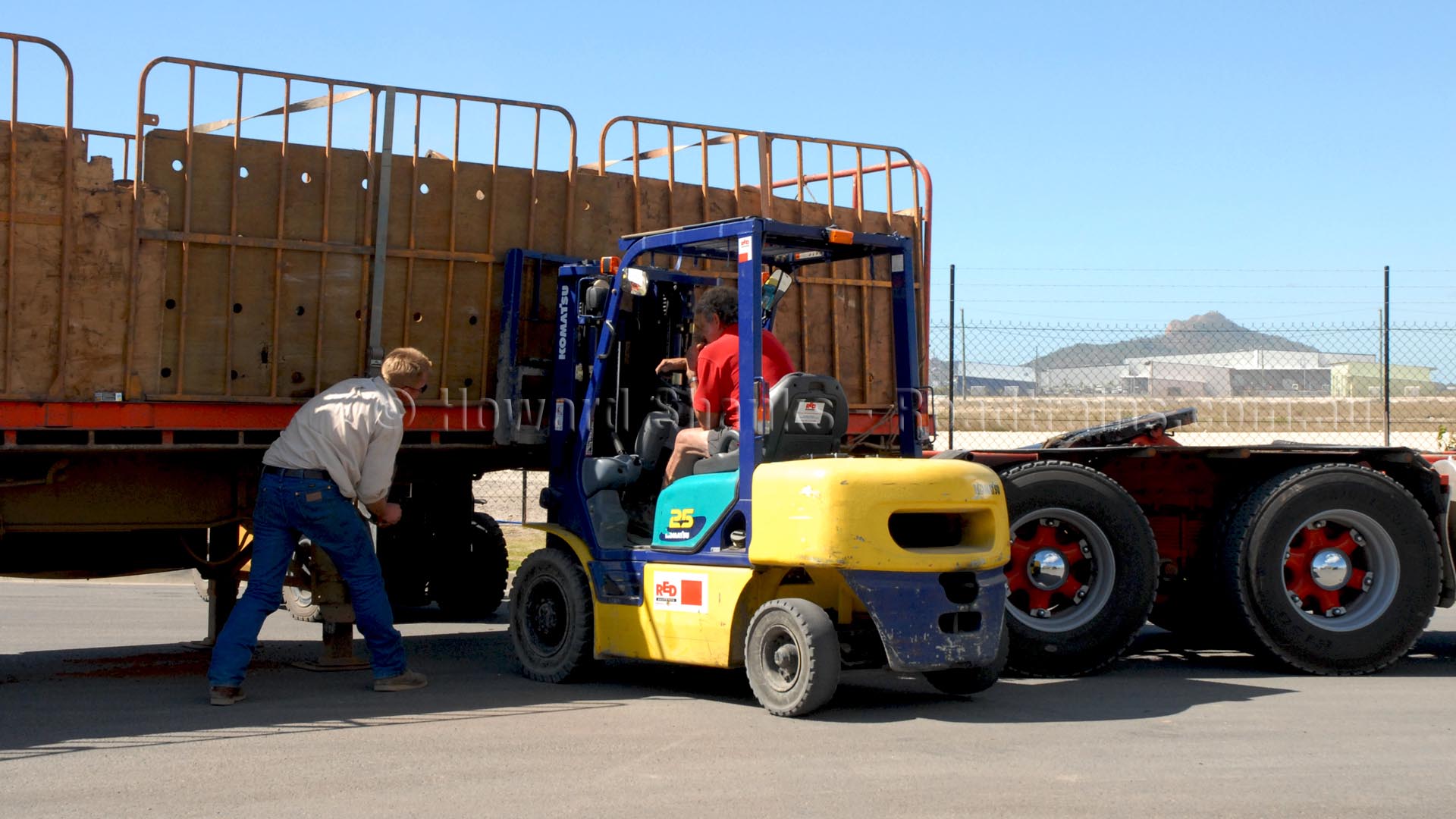
A dropped trailer causes expensive recovery costs
Training Mapping
The following procedure aligns with the follow national competencies in the TLI Transport and Logistics Training Package.
TLIC4006 Drive multi-combination vehicle
- 2 Prime mover, dollies and trailer are aligned and coupled in proper sequence in accordance with manufacturer instructions and workplace procedures
- 3 Coupled vehicle is checked and tested to ensure it is correctly secured and to confirm it is fully operational
TLIC3005 Drive heavy combination vehicle
- 2 Prime mover and trailer are aligned and coupled in accordance with manufacturer instructions and workplace procedures
- 3 Coupled vehicle is checked and tested to ensure it is correctly secured and to confirm it is fully operational
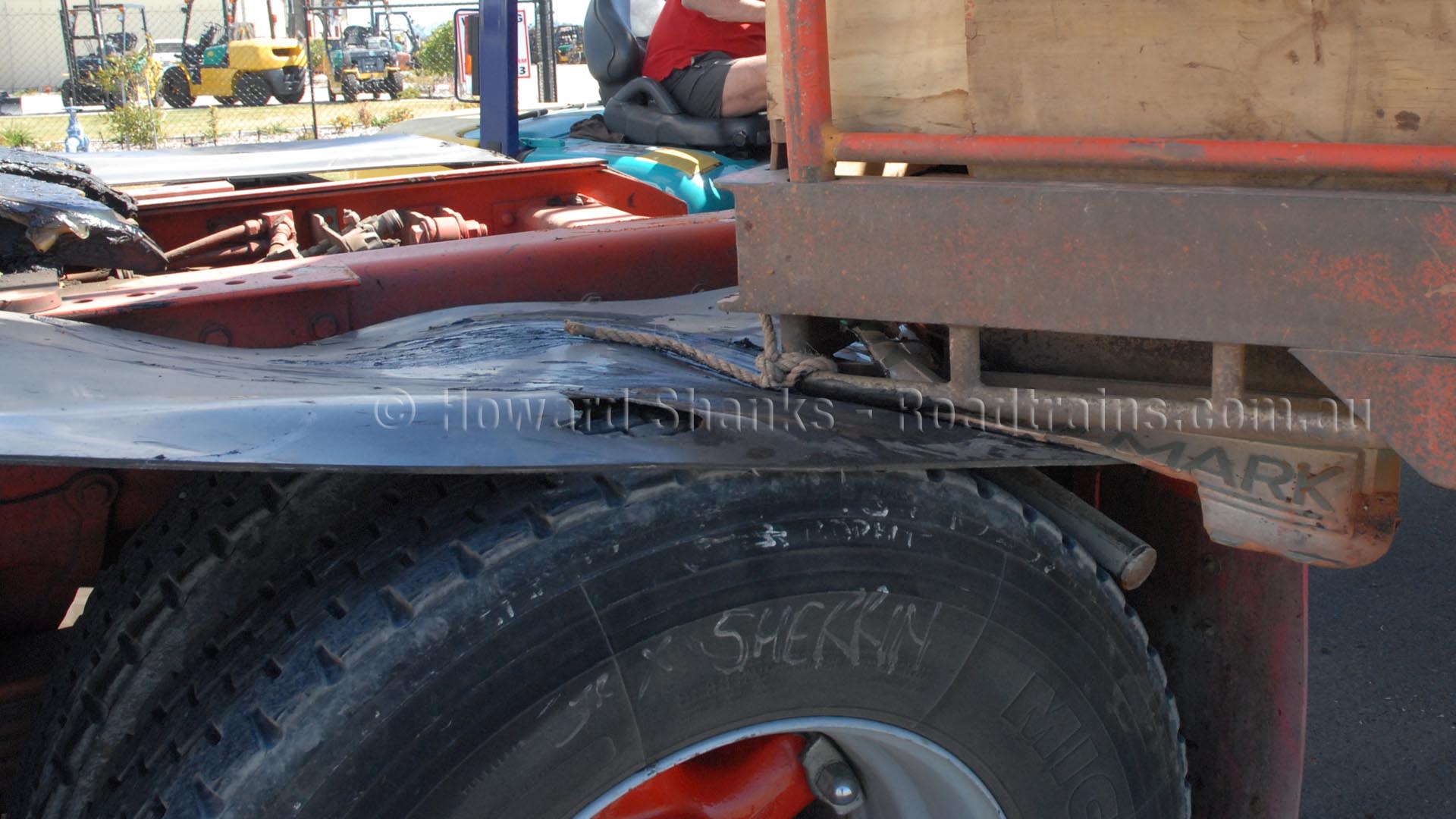
A dropped trailer causes damage to equipment and has expensive recovery costs
Definitions
- Fifth wheel: A device used for coupling a prime mover to a semi-trailer. A fixed Fifth-wheel as the term suggested is fixed to the prime mover and the king pin and trailer skid plate rotate while resting on top of the fifth wheel.
- Ballrace Turntable: Has a base fixed to the prime mover and the top attached the to fifth wheel and it rotates easily via series of internally mounted ball bearing. On trailers fitted with a block the trailer moves with the top plate of the fifth wheel.
- King pin: A pin on a semi-trailer skid plate that locks into a prime mover’s fifth wheel jaw – this is the one we refer to in this document. However it is also the pin around which a steerable wheel rotates in the vertical axis.
- Skid Plate: A thick steel plate fixed to the underside of the front of a semi-trailer and incorporating the kingpin (and often a block to keep the skid plate from turning on the upper part of fifth wheels mounted on ballrace turntables). The front of the plate is usually curved upwards to enable the prime mover to slide more easily under the trailer during coupling.
- Throat: The opening at the rear of the fifth wheel to allow the king pin to easily move into the jaw.
- Jaw: The mechanism that wraps around the king pin securing it to the fifth wheel.
- Locking Bar/Wedge: The secondary mechanism to ensure the king pin is secure in the fifth wheel.
- Secondary Safety Latch: The tab that ensures the Release handle will not come loose during travel.
- Release Handle: The handle to release the jaw when uncoupling the trailer.
- Non-Metalic: Greaseless fifth wheels use Non Metallic pads to reduce friction between the skid plate and the fifth wheel top. This means that grease is not required on the top plate, giving the obvious benefits of reduced grease costs and less cleaning for maintenance.

Check for a block behind the king pin
Coupling
Step – 1: Inspect (For Block & Open Jaw)
Before coupling the prime mover to the trailer you should do the following inspection:
- Check the trailer skid plate. Has the trailer got a block welded or bolted to the plate behind the kingpin? If so, is the turntable compatible and unlocked?
- Check the skid plate, kingpin, turntable, fifth-wheel and jaw for damage and size (i.e. 50mm or 90mm)
- Make sure the jaw and wedge are not visible in the throat of the fifth wheel, this is known as the open position. If the jaw and wedge are visible lift the Secondary Safety Latch and move the handle towards the front to release the lock then pull the handle out as far as it will go. With the handle pulled out swing it forward to engage the edge of the plate. Now fifth wheel is in the open position and the jaw and wedge are set to accept the trailer king pin.
- For fixed a fifth-wheel make sure the top plate is well greased or Non Metallic plate is not damaged.
- For trailers without a block the turntable will need to be in the locked position and the top of the fifth-wheel well greased.
Step – 2: Connect
Reverse the prime mover into position straight in front of the trailer. Use your mirrors to line up the sides of the trailer with the outer sides of the prime mover’s mudguards and reverse back so that the rear mudguards on the prime mover are in line with the front of the trailer. Apply the park brake, get out of the cabin and check that the fifth-wheel and kingpin are lined up. (i.e. the fifth-wheel is not turned off centre – on a ballrace turntable).
Check that the height of the trailer skid plate is at least the same height as the fifth wheel.
If the trailer is too low, the prime mover chassis and turntable can hit the trailer front and cause damage. (Air lines, electrical connections, body of van).

Secondary Safety Latch engaged
Lower the airbags and select low reverse, and then slowly reverse the prime mover until the fifth-wheel is under the skid plate, stopping with the front of the trailer at the edge of the front guards. This prevents all the grease being scrapped of the top the fifth-wheel.
Raise the air bags to ride height until the legs are clear of the ground.
Visually check the landing legs are clear of the ground, and there is no air gap between the skid plate and the turn-table. Resume slow reverse under the trailer until the fifth-wheel jaw lock around the kingpin. You should hear a distinct “Clunk” as the jaw close and lock into place.
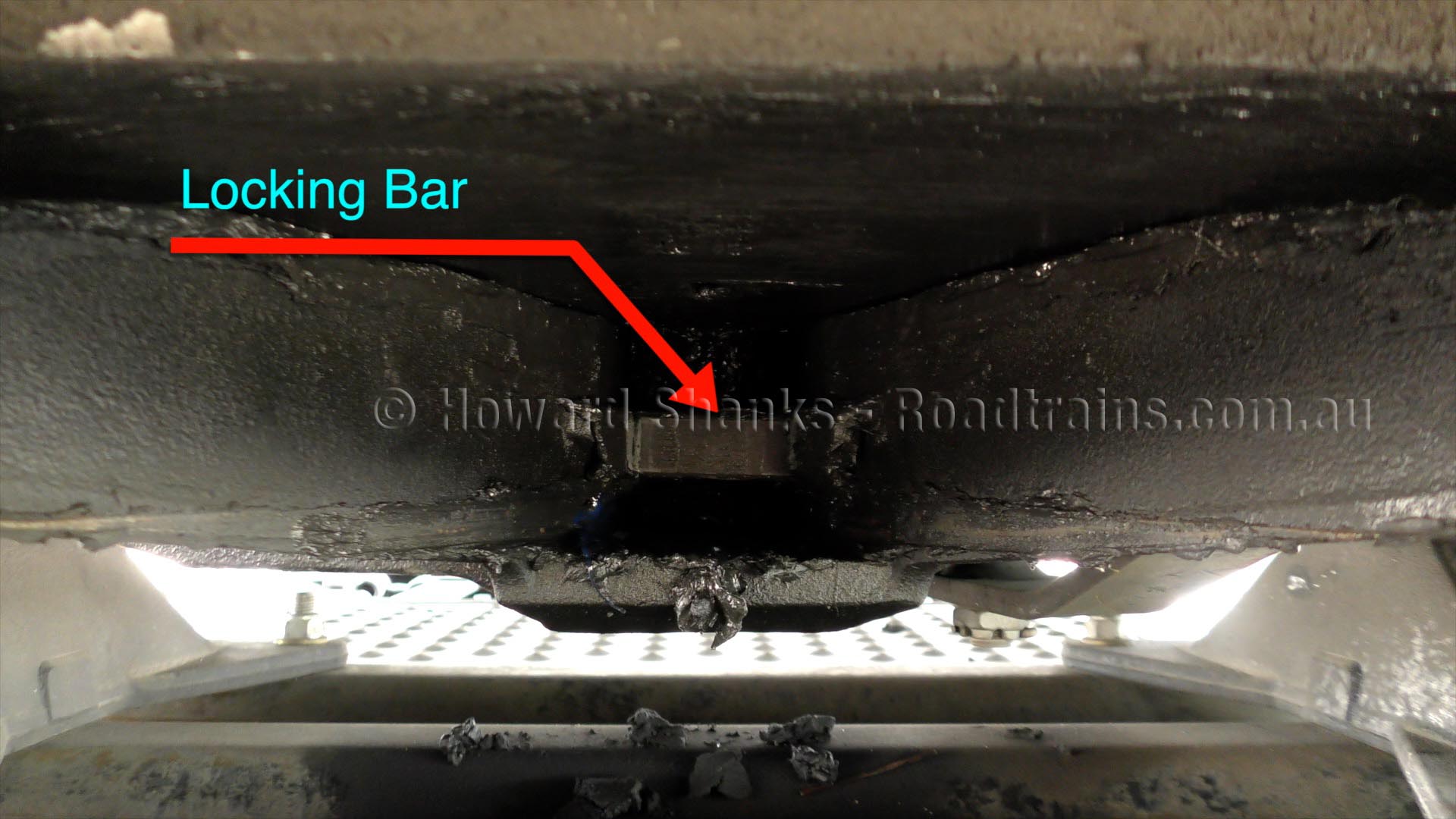
Check locking bar is across the King pin and there is no air gap between the top of the fifth wheel and trailer skid plate
Step – 3: Test
Tug Test. Check the trailer is locked on by selecting first gear then letting up the clutch to the friction point, in first gear. The prime mover should not move. Apply the park brake.
Get out and visually check that the coupling release lever or pull handle has fully retracted and the secondary locking latch has dropped into its downward position. Some levers require a manual lock tab, this must be used to prevent the lever opening while towing. If the locking tab or the safety chain cannot be fitted, the turntable is not locked.
Use a flashlight if necessary and go under the trailer and look into the back of the throat of the fifth wheel. The locking mechanism should be engaged across the entire throat of the fifth wheel and secured around the kingpin.
Make sure the head (bottom flange) of the pin is not sitting on top of jaw. Also the trailer is sitting firmly on the fifth wheel by checking there is no gap between the fifth wheel and the trailer skid plate.
If there is space, the kingpin is not coupled. In that case, lower the landing gear, and slowly ease the prime mover forward until the fifth wheel comes out from under the trailer. Inspect the fifth wheel including the lock for any damage caused by the improper coupling attempt. If damage is found, repair or replace the fifth wheel before attempting to re-couple to the trailer. Repeat the coupling procedure until there is no space between the fifth wheel, the skid plate on the trailer.
Raise the landing gear. Keep winding until fully raised. Leave the landing gear engaged. Make sure the handle is properly stowed, or damage can occur.
If using a trailer for the first time, check the clearance movement between the prime mover (frame and wheel guards) and the trailer. Check also that there is enough clearance between the landing gear and the back of the truck frame to allow for turning.
Connect air hoses and electrical cables. When connecting airlines ensure the connection tabs are locked on the joiners (1/4 turn). If fitted, the shut-off valves are turned on to supply air and charge to the trailer. With prime movers with the air supply valve on the interior dash it is advisable to activate supply while the trailer check is done as this will charge the air systems on the trailer (brakes and air suspension).
Check to ensure that all the lights on the trailer are working.
Remove and stow wheel chocks when used.
Step – 4: Check
Reset the air bag level to the normal travel position. Before moving off, do a SECOND tug test by applying the trailer brakes and again taking up the friction point in first gear. This is to confirm your trailer is securely hitched and the trailer brakes are serviceable.
Finally – as you move forward at low speed (5kph) and in a straight line, do a
THIRD TUG TEST by slowly applying pressure to the trailer brake hand piece.
This confirms that the trailer is securely hitched, and the supply and service pressure to the trailer brakes have reached operating levels, and the trailer should dip slightly to confirm that the brakes are adjusted correctly.
Uncoupling
Step – 1: Position
Before uncoupling make sure your combination is parked on a level surface, which is firm enough to support the trailer landing gear and its load. If you have to uncouple on soft ground, put a suitable strong timber or other flat supports under the landing gear.
Make sure the prime mover and semi-trailer are in a straight line
- Apply the maxi brakes (parking brake) on prime mover.
- Chock the trailer wheels if required. Modern trailers are fitted with Spring Brakes; however, this is still a requirement at some sites.
- Always use chocks where rear-loading trailer is performed off a dock and if it is necessary to park on a grade. It is best to chock the semi-trailer’s front axle in case the landing legs collapse and the rear axles lift.
Step – 2 Disconnect Cables & Lines
Disconnect the air hoses and electrical cables from the trailer.
Stow them properly on the prime mover making sure that the connectors are kept free of water and dust, and they cannot get caught on the tailshaft. Make sure air supply taps are turned off (if fitted).
Lower the landing gear until the supports are in contact with the ground. Ensure visual check is conducted to make sure both legs have been lowered.
Step – 3: Release the Jaw
To release the fifth wheel jaw. Raise the Secondary Safety Latch and move the handle towards the front to release the lock then pull the handle out as far as it will go. With the handle pulled out swing it forward to engage the edge of the plate. Now the fifth wheel is in the open position.
If the release handle cannot be moved, the jaw may be under load. Take the pressure off by rocking the prime mover forward and back and then try to release again.
Step – 4: Drive Forward.
Release the prime mover parking brake and slowly drive forward 10 – 20 cm in a straight line; dump the air bags, wait until there is a gap between the trailer skid plate and the top of the fifth wheel. This ensures the trailer is sitting firmly on the landing gear, if not it gives the opportunity to rectify the situation with out any damage to the equipment. Then drive forward until the fifth wheel is just clear of the trailer skid plate. Make sure the trailer stays put.
Air bag suspension prime movers. Ensure the airbags are down prior to completely clearing the trailer. If they are still fully inflated damage may occur to the mudguards and the trailer or the king pin could get hooked on the rear cross member of the prime mover chassis.
If necessary use the dump valve. Note: some prime movers may take longer to dump the air bags.
After the prime mover has completely cleared the trailer, reset the airbags to the normal traveling height.
It is advisable when parking the prime mover at the end of shift or for any length of time and you are disconnecting the trailer, to pull the prime mover clear of the trailer and reset the air ride height to the normal traveling height.
Many companies are now enforcing disciplinary action and seeking compensation from individuals who cause damage through negligence by not following company coupling and uncoupling procedures.
Jost’s Bob Martin demonstrates the operation of the popular Jost JSK37 fifth wheel.
You might also like to read about: How to operate a Jost Sensor 5th Wheel

